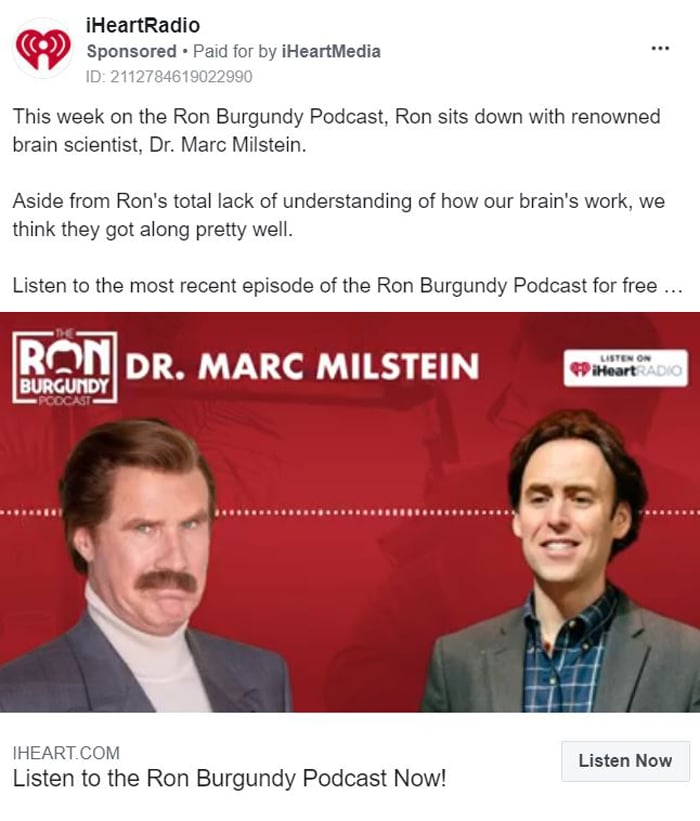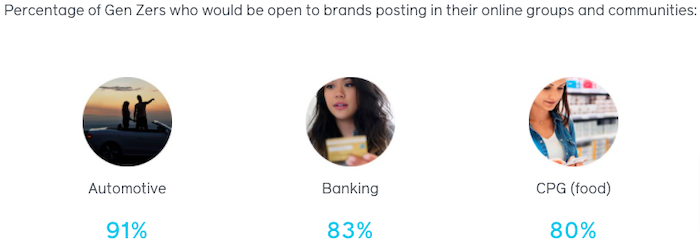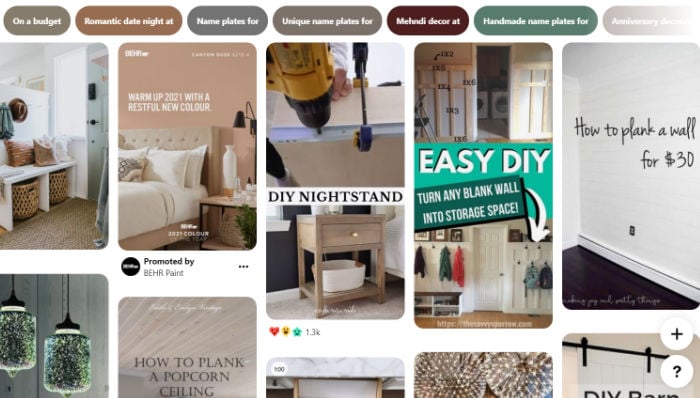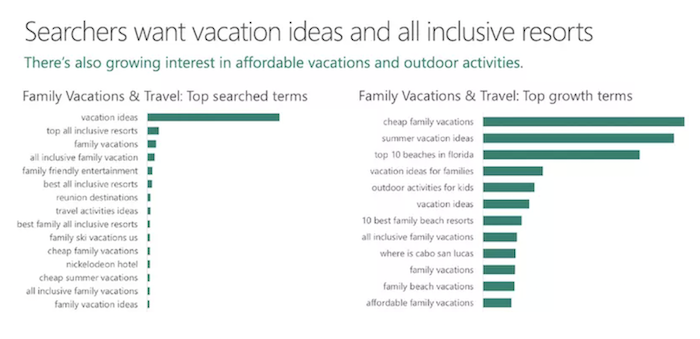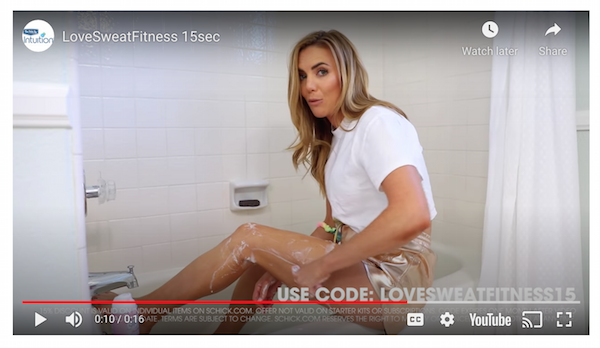
How to Use Paid Ads to Market to Pet Owners Effectively
American pet owners are some of the biggest spenders online, pet food and pet supplies being second only to vitamins for e-commerce.

Online spending for this $70 billion industry is growing year over year.
In fact, direct-to-consumer (DTC) pet brands have exploded in popularity: Over five years, the online pet product sellers saw a compound annual growth rate of 24 percent.
From special-diet foods to raincoats for dogs, desirable pet products can be very specific. Paid ads on search and social let you bid on relevant keywords to hyper-target an audience that perfectly fits your brand.
In this article, I’ll give you nine ways to use paid ads you could effectively market to pet owners.
9 Ways to Target Pet Owners Using Paid Ads
Downtown Pet Supply, an Illinois-based company that makes its own products and sells them both online and in their store, wanted to improve its e-commerce sales and expand customer reach.
They turned to marketing firm Tinuiti (then called CPC Strategy) to help them do that through Amazon. Tinuiti decided to utilize Amazon Coupons targeting pet owners based on their Amazon search histories.
After one year, Downtown Pet Supply’s revenue increased by 40 percent, and its advertising cost of sale (ACoS) decreased by 18 percent.
That’s the power of using paid ads to target pet owners.
Common Thread Collective reports 13 percent of pet supply sales happen via e-commerce channels—and that’s expected to grow drastically over the next several years.

The anticipated increase in e-commerce purchases for pet supplies is largely because of convenience and value. However, shoppers also appreciate being able to find a larger selection and compare prices more easily than in brick-and-mortar stores.
Even for brick-and-mortar establishments, paid ad campaigns can extend customer reach and raise awareness of their brands.
Here are the best ways to harness the power of paid ads to help your company boost revenue.
1. Answer Pet Owners’ Questions
When pet owners go online, they’re looking for a solution to an immediate problem. It may be their pet is sick, and they want to know why. They may need chew toys or a scratching post. Or, they may just be looking for a convenient place to buy everyday pet supplies.
The most common question pet owners ask is, “Why?”
Here are the top 10 questions pet owners ask Google:
Why do dogs:
- Lick?
- Eat grass?
- Eat poop?
- Howl?
- Hump?
- Smell?
- Bark?
- Shake?
- Scratch?
- Bite?
Why do cats:
- Purr?
- Knead?
- Lick?
- Meow?
- Bite?
- Rub?
- Scratch?
- Eat grass?
- Sleep so much?
- Like boxes?
Each of these questions presents a micro-moment brands can address through ads or content marketing. They also create starting points for keyword research.
2. Use Content Marketing
Typically, your content marketing addresses those micro-moments for your users. Blog posts and articles can answer those health, feeding, grooming, and other questions.
But, you don’t have to rely solely on SEO to get those posts found. You can also promote your posts through social on platforms you know your audience is using.
PetPlate, a meal plan subscription service for dogs, created this promoted pin on Pinterest to boost a blog post called “Tips for Welcoming a New Puppy Into Your Home.”
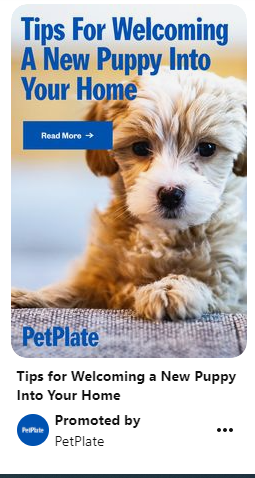
By directing users to their blog posts through Pinterest ads, PetPlate not only raises awareness of their brand but sets themselves up as a thought leader in their space.
3. Research Keywords Pet Owners Use
One major benefit of paid ads is the reliability of keywords. With organic search, you’re essentially making a well-researched guess about which keywords will perform.
With paid ads on Google, Facebook, and other platforms, you bid on keywords that already perform. High-performing keywords cost more, but they may not even be the keywords you want.
Instead of getting lost in a sea of ads vying for the most popular keywords, try going after less expensive keywords with lower, but steady performance.
For example, “pet beds” is a generic, popular keyword a lot of companies are bid on. However, if you sell, say, “machine washable cat beds,” consider going after those keywords instead.
Whatever you do, make sure your keywords match your target audience as well as your product or service.
Pro Tip: If you want to direct traffic to your products, insert the word “buy” in front of a keyword. For example, for “pet beds,” try “buy pet beds.”
4. Research Your Social Media Platforms
Millennials are the largest pet-owning demographic in the U.S., according to the American Pet Products Association (APPA).
APPA President and CEO Bob Vetere says, “We know this generation is willing to pay more for quality products and services to improve the health and well-being of their pets. Today more than ever, pet owners view their pets as irreplaceable members of their families and lives, and it’s thanks to this that we continue to see such incredible growth within the pet care community.”
According to a study by online retailer Zulily, 77 percent of millennials prefer to buy certain pet products—toys, accessories, and food—online. However, there are no pet products strictly bought in-store these days, so it’s important to know where you can reach this audience.
Luckily—or unluckily, depending on how you look at it—”Millennials utilize a diverse range of platforms since many platforms were released while they were growing up. Facebook is the platform that they utilize most frequently, often multiple times a day, followed by YouTube and Instagram,” according to GenGuru.
However, since they grew up as social media started taking steam, they’re also on pretty much every other social media site. Trying out all sorts of new media is normal for them.
This all means you should not just look at the age group but also try to discover where products like yours fit the best. Then, put your money where it’s more likely to reach your target audience.
5. Use Images or Videos in Pet Ads
Purina wanted to learn if in-stream ads on Facebook could lift brand awareness with mobile users for a new product in their Fancy Feast line of cat food, Fancy Feast Savory Centers.
In the first phase, they tested a variety of videos for other pet brands they owned, playing with length and messaging. They learned short, clear ads lifted brand recall, video views, purchase intent, and offline sales.
With that knowledge, they repurposed an existing TV ad for Fancy Feast Savory Centers to a web video. In the process, they shortened it to fewer than 15 seconds and ensured it had a clear message with or without sound. They tested it against the TV ad to see which better raised brand awareness.

They ran the test for six weeks through Facebook In-Stream Reserve, a line of premium ad spots, and found an 11 point lift in brand recall, 12 point lift in brand awareness, 91 percent video completion, and 1.5 percent incremental lift in sales.
You don’t necessarily have to target the most expensive video packages online as Purina did, but video and images can have a big impact on your paid advertising online.
Consider another example.
Below, there are paid ads for pet beds on the left and right sides of the Google search results. On the left are text-only ads, and on the right are Google Shopping Ads that feature images.

Google found 50 percent of online shoppers are more likely to purchase if there’s an image of the product.
6. Provide a Service
To convert and keep new customers, you have to build relationships with them. Offer something that makes their lives, and the lives of their pets, easier.
If you’re already a service-based brand, that’s pretty easy to do. If you’re product-focused, you can still provide a service.
Let’s take another look at PetPlate.
Their paid ads for their product actually spin it as a service. They provide fresh-cooked food for dogs so owners don’t have to.

This ad showed how PetPlate could solve a problem for its audience.
7. Target Pet Owners in a Specific a Geographic Area
Brick-and-mortar stores and services might consider targeting a particular geographic area, something that’s very possible with Facebook, Instagram, and other platforms that allow for hyper-targeted advertising.
Of course, veterinarians, groomers, and other service-based businesses can benefit from geo-targeting on social. However, boutiques and small businesses that sell pet food and other supplies shouldn’t overlook the power of location-based social media ads.
According to Zulily’s study, millennial pet owners prefer to shop for some products in person at smaller, locally owned pet shops. Those products include treats, bedding, and clothing items.
If you want to get super local, check out a social platform made for your area. A commonly-used app, Nextdoor, lets advertisers both pay for ad space and engage with users in their immediate areas.
Nextdoor may be a good choice because they report 45 percent of users have at least one dog and 25 percent have at least one cat. They also note that pets are a regular topic of conversations on their platforms. Why not become part of the conversation with paid ads?
9. Use an Influencer or Celebrity to Target Pet Owners
There are two types of influencers pet brands can go after: Humans and animals.
There are plenty of human celebrities and influencers across social media who include their pets in their content.
Priyanka Chopra Jonas and Nick Jonas, for example, regularly feature their dogs Diana, Gino, and Panda on their Instagram accounts.
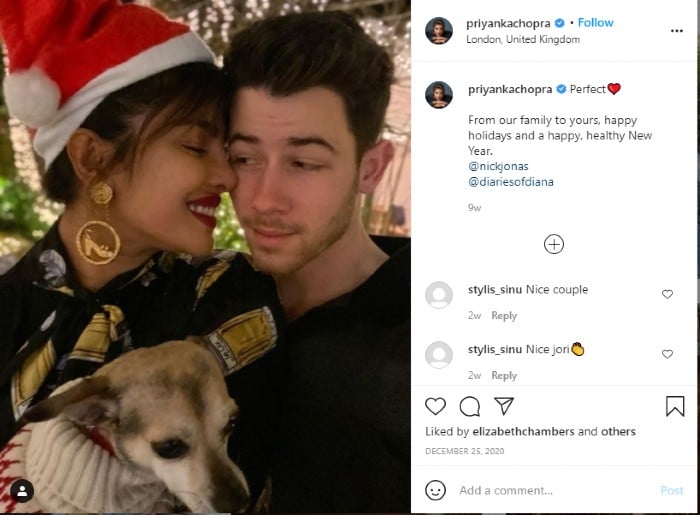
The second type of pet influencer is the furry, scaly, and feathery type. Pet influencers, particularly cats and dogs, have a huge presence on virtually all social media platforms.
In fact, pet influencer content has a higher engagement rate than overall global engagement. While cats rule the internet overall, dogs are actually more popular on Instagram.

There are all kinds of pet celebrities out there, from cats and dogs to pigs and hedgehogs.
For instance, Waffles the cat is a celebrity on Facebook with 2.4 million followers.

Meanwhile, on Instagram, Tuna the dog commands a following of 2.1 million.

Take a look at your audience and their social media habits. Who are they following? Do they have two legs or four? Then, choose the influencer that best fits your brand and your goals.
Conclusion
Paid ads on search and social media are an effective way to market to pet owners. It gives brands the opportunity to reach very specific audiences for their products and services, and then measure the success of each campaign.
Pet owners spend a lot of money online, and knowing where and how to reach them could help you increase conversion rates to your own pet supply site.
How could paid ads help your pet supply brand?




